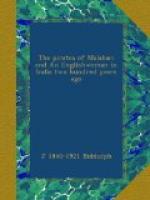To the lookers-on the marriage was repugnant, and can hardly have been a happy one for the young girl, as Harvey was ‘a deformed man and in years.’ He had been long on the coast, and by diligent trading had acquired a little money; but he had other things to think of besides his private trade, as we find recorded at the time that ’the Rajah of Carwar continues ill-natured.’ By the end of 1710, he made up his mind to resign the Company’s service, wind up his affairs, and go to England; so Mr. Robert Mence was appointed to succeed him at Carwar, and, in April, 1711, Harvey and his child-wife came to Bombay. But to wind up trading transactions of many years’ standing was necessarily a long business, and there was no necessity for hurry, as no ship could leave for England till after the monsoon. As always happened in those days, his own accounts were mixed up with those of the Company, and would require laborious disentanglement. Before leaving Carwar, he had leased to the Company his trading grab, the Salamander, and had taken the precaution to pay himself out of the Company’s treasure chest at Carwar. Before long, there was an order to the Carwar chief to recharge Mr. Harvey 402 Pagodas, 17 Jett, and 4 Pice he had charged to the Company for the use of the Salamander, the account having been liquidated in Bombay; from which it would appear that he had been paid twice for his ship. The accounts of those days must have been maddening affairs owing to the multiplicity of coinages. Pounds sterling, Pagodas, Rupees, Fanams, Xeraphims, Laris, Juttals, Matte, Reis, Rials, Cruzadoes, Sequins, Pice, Budgerooks, and Dollars of different values were all brought into the official accounts. In 1718, the confusion was increased by a tin coinage called Deccanees.[1] The conversion of sums from one coinage to another, many of them of unstable value, must have been an everlasting trouble.[2] In August we find Harvey writing to the Council to say that he had at Tellicherry a chest of pillar dollars weighing 289 lbs. 3 ozs. 10 dwts., which he requests may be paid into the Company’s cash there, and in return a chest of dollars may be given him at Bombay.




